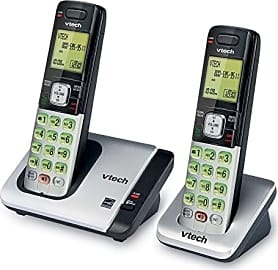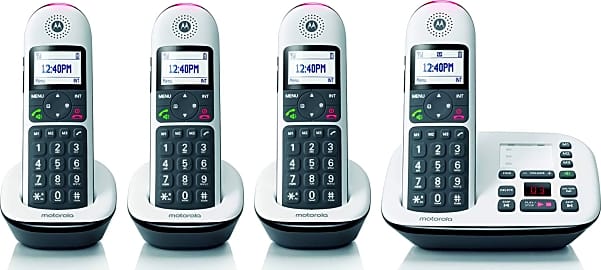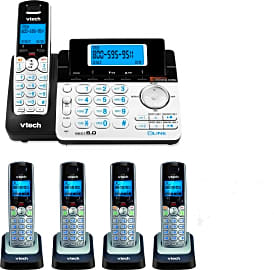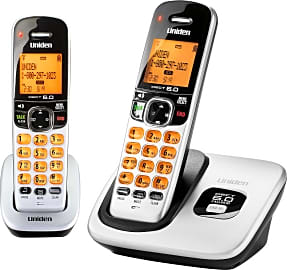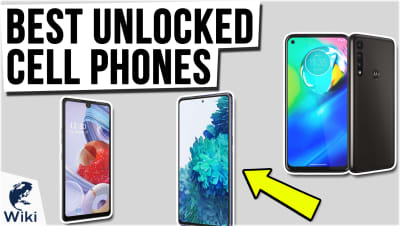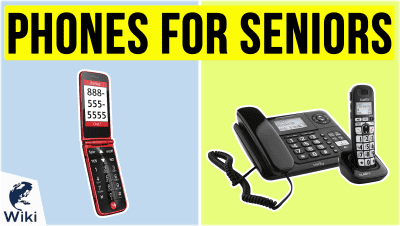The 10 Best Cordless Phones

This wiki has been updated 39 times since it was first published in February of 2015. If you want the security or backup of a land line for your house or have a small business to run, take a look at our selection of cordless phones. Depending on the model, they come with a range of features, including digital answering systems, call transfer, and conferencing capabilities, and all will ensure you stay connected at work or home without getting tangled up in wires. When users buy our independently chosen editorial recommendations, we may earn commissions to help fund the Wiki.
Editor's Notes
November 11, 2020:
While there may not be the level of innovation going on in cordless phones for landlines these days as we see in cell phones, that doesn't mean you can't get one with some high-tech features. Perhaps no model proves this more so than the Motorola AXH01, which features Amazon's Alexa. This means it can do many of the things your Echo or Dot device can do, including accept voice commands for making calls directly to someone else's Alexa-equipped device, provide you with news and weather reports, and set reminders.
The VTech IS8151 and Panasonic Link2Cell also boast some high-tech features, perhaps most notably the ability to be paired with cell phones via Bluetooth, allowing you to take calls on your landline instead of your mobile device when within range. You'll also get intercom functionality, ambient noise suppression, and smart call blockers with both, and visual ring notifications with the VTech IS8151.
Those with hearing impairments can look to the Motorola CD5014, which not only provides visual ring notifications, but also has a dedicated amplification button and is hearing aid compatible. You can find additional options good for those with impairments of various kinds on our list of phones for seniors, however they won't all be cordless.
June 12, 2019:
For a land line you can count on for your home or business, AT&T and Panasonic models are still the ones to beat for most, with VTech not far behind. Currently, we like the Panasonic Link2Cell for its Bluetooth connectivity, which allows you to sync it to your smartphone not only for calls but also for Siri and S Voice. Plus, it will store a whopping 3,000 numbers in its phonebook and block 250 numbers to get rid of unwanted calls. Another option we like for its connectivity is the Motorola AXH01, which has Alexa integration. For instance, you can ask for your notifications or have Alexa find a contact and dial for you, so you don't have to remember numbers or speed dial positions. This option is somewhat expensive, however, when you consider that the base comes with one handset.
If such high-tech options will strain the budget, or be too complicated for the intended user, there's also the VTech CS6719-2 and the AT&T EL52313. Each offers several handsets for a low investment, and they have features that make them simple and usable, rather than flashy and tech-heavy. Some dislike the buttons on the VTech model, though, since they can feel clunky or unresponsive. But it does come in three colors, if that sort of thing is important to you.
Special Honors
Clarity XLC4 The Clarity XLC4 is a fine option for those who might be struggling with hearing or vision loss, thanks to clear, amplified sound and big, high-contrast buttons. It also amplifies outgoing speech for two-way clarity and flashes when it's ringing. clarityproducts.com
Gigaset E630A GO For those who use VOIP and analog, the Gigaset E630A GO is rugged, reliable option with plenty of bells and whistles. In fact, it's got changeable wallpaper and a flashlight built right in, so it feels more like a cell phone than the clunky home phone of yesteryear. gigaset.com
How Does a Cordless Telephone Work?
Beyond the use of radio waves, a cordless telephone transmits an analog or digital signal in much the same way an old-school telephone does.
The easiest way to explain how a cordless phone operates is by pointing out that the curly wire (attached to a traditional phone) is essentially being replaced via radio waves. Unlike the wire, these waves can travel over and through any objects in their path. As a result, you get a more versatile piece of hardware that comes with some pretty cool little extras, as well.
Beyond the use of radio waves, a cordless telephone transmits an analog or digital signal in much the same way an old-school telephone does. The cordless phone's docking station (i.e., its "transceiver") is connected to a telephone wire, which is, in turn, connected to a phone jack in the wall. This jack attaches to a much longer wire which runs outside to either a nearby telephone pole or an underground telecommunication system, where all of the individual wires have been bundled into a network.
If there is one critical difference between a cordless phone and a rotary phone it is that the cordless phone requires constant electricity - and a rechargeable battery - in order to function. This may seem like a limitation (and an extra expense), but it's a minor drawback, especially given today's docking stations can accommodate multiple lines and multiple headsets, while also allowing for some degree of smartphone compatibility (depending on the cordless phone that you're using).
What Do I Need to Know Before I Buy a Cordless Phone?
Most landline phones these days are cordless, so the primary decision comes down to whether you need a phone for the home or the office. In-house cordless phones are pretty straightforward. They come with one or two handsets, a built-in answering machine (or voicemail service), and a digital display including Caller ID. Some models have better sound than others, but your major focus should be on finding a cordless that matches the decor and doesn't take up too much space. You may also want a cordless that comes with some sort of call blocker, given telemarketers tend to focus on calling people at their homes.
Most landline phones these days are cordless, so the primary decision comes down to whether you need a phone for the home or the office.
If, on the other hand, you're buying a phone for the office, you have a lot of aspects to consider. Assuming the phone will serve any type of administrative function, you'll probably want a model that can forward calls and page people. Assuming you plan on putting the phone in a conference room, you'll want to make sure it has a reliable speaker. In addition, check out how many handsets/headsets the central docking station can accommodate. During conference calls, it's helpful to have two or more people on the line.
If the phone is for one employee, the most important feature might be smartphone compatibility. The majority of executives are mobile these days, and a lot of them spend more time out of the office than they do in. That being the case, it's almost essential to have an office phone that can forward calls to an executive's cell phone, while also allowing him or her to access business voicemail on the go.
A Brief History of the Cordless Telephone in America
Like a lot of innovations, there is some debate regarding who is actually responsible for putting the cordless telephone on the map.
One story has it that a jazz musician named Teri Pall invented the basic technology for a cordless phone in 1968, but had no idea how to modify it, and so he sold that technology to a manufacturer for next to nothing. What that manufacturer may not have known was that a U.S. Army radio operator named George Sweigert was already a few steps ahead of him.
Like a lot of innovations, there is some debate regarding who is actually responsible for putting the cordless telephone on the map.
Sweigert had discovered a connection between in-the-field military communications and the practical application of similar technology to allow for wireless communication in the home. Radio waves were the key to what Sweigert termed a "full duplex wireless communications apparatus" on his original patent application back in 1966.
Sweigert's application wasn't approved until 1969, as technology with that capability needed to be thoroughly vetted. The idea of allowing for open access to radio-wave communications raised questions regarding the potential for breach of privacy, and even national security.
Not a lot happened with Sweigert's invention until the late seventies, when Douglas Talley and Duane Gregory introduced a "duplex communication link involving a base station connected directly to a telephone exchange" (aka the cordless phone as we know it). While the cordless has experienced certain technological advances over the years, the basic premise surrounding it has remained very much the same.






